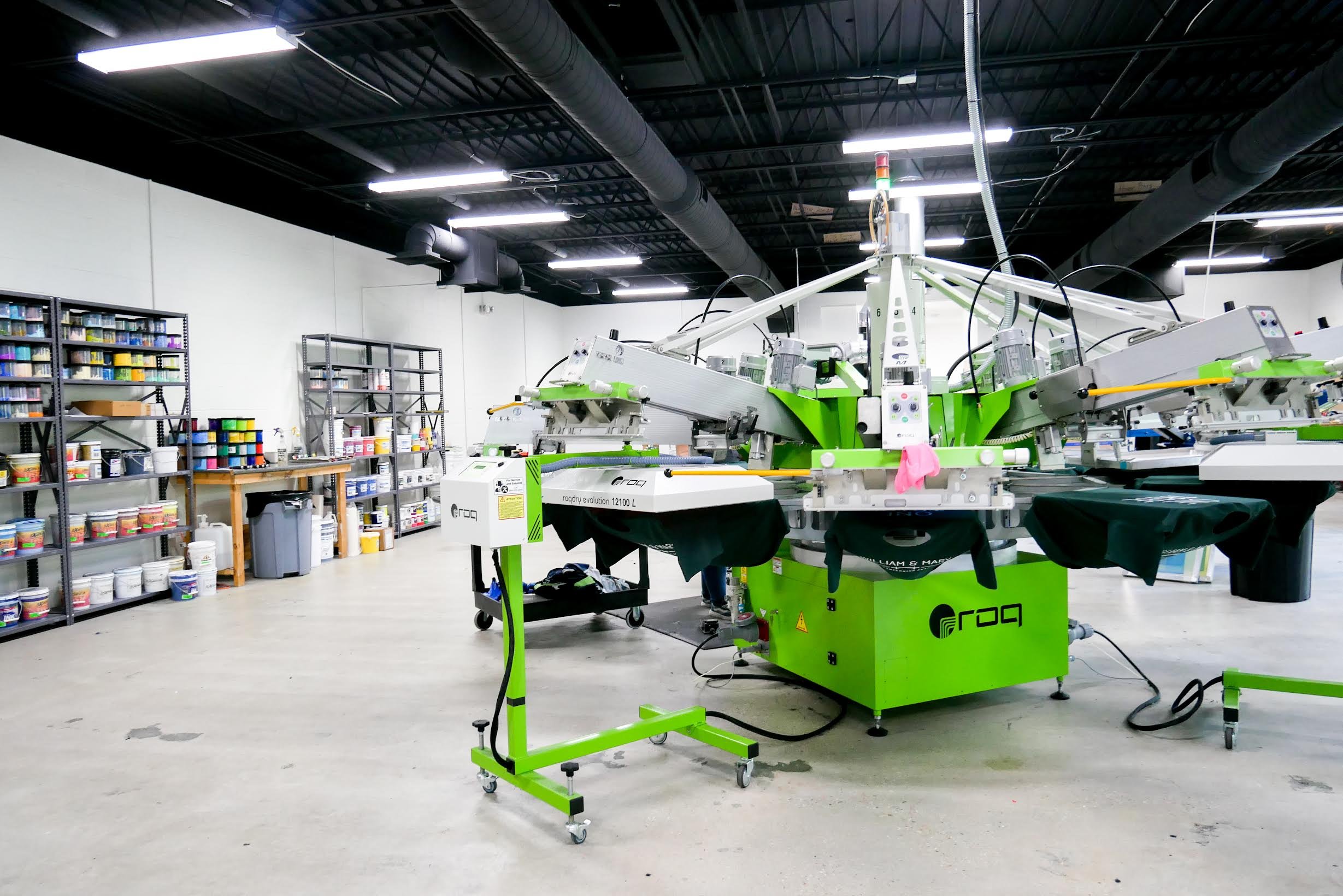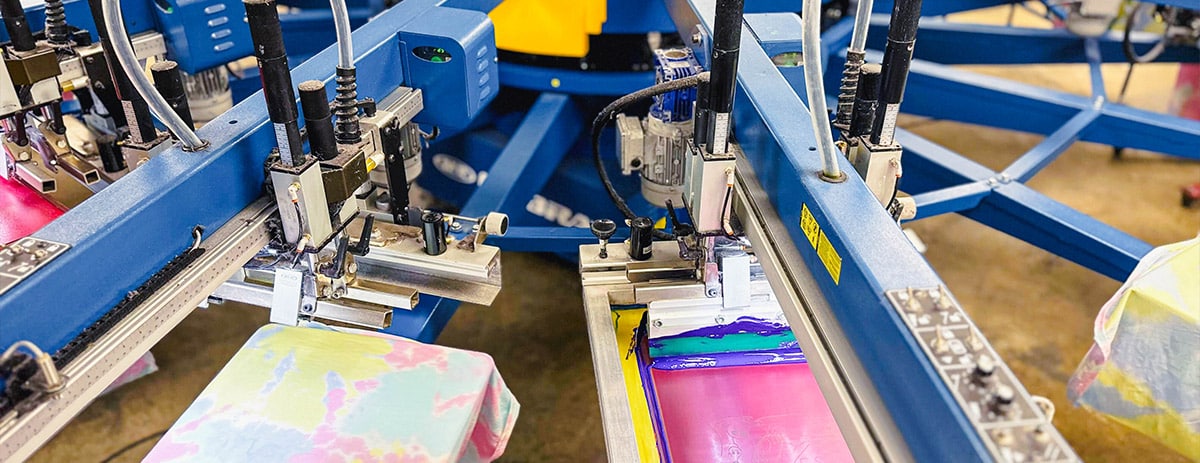High-Volume T-Shirt Printing for Schools and Organizations
Screen Printing Uncovered: Every Little Thing You Need to Understand About Tee and Garment Printing Strategies
If you've ever before wondered exactly how those lively styles wind up on your preferred tee shirts, you remain in the best location. Screen printing is a fascinating method that incorporates art with technique, offering unlimited possibilities for creativity. Recognizing the basics, from tools to ink selections, can significantly influence your outcomes. All set to explore the vital components that make screen printing an art type? Allow's reveal the details that can raise your tasks.
The Basics of Screen Printing: Just How It Works
When you plunge into display printing, you'll discover it's both a science and an art. At its core, screen printing includes creating a pattern, or display, that enables ink to go through only in specific areas (screen printing kit). You start by choosing your design and preparing your screen with a light-sensitive solution. Once you subject this solution to light, it sets, leaving your design as an unfavorable room.
Following, you'll mix your inks and prepare your printing surface. Placement the screen over the fabric, after that use a squeegee to push ink through the display onto the garment. This process needs accuracy, as you want clear, dynamic prints. After printing, you'll cure the ink with warmth, guaranteeing it abides by the material and lasts via washes. Each step is essential, and mastering them will certainly boost your screen printing abilities, changing straightforward garments right into unique, meaningful pieces.
Kinds Of Display Printing Strategies
As soon as you understand the fundamentals of screen printing, it's time to check out the different techniques that can boost your layouts. One preferred approach is conventional display printing, where ink is pushed via a stenciled screen.
One more option is plastisol printing, known for its resilience and vivid colors, making it a favorite for lots of brands. Experiment with halftone printing to develop slope results and detailed designs.
Crucial Devices for Screen Printing
To achieve spectacular results in screen printing, having the right tools is essential. You'll require a sturdy screen printing framework, which holds the mesh that transfers your design onto the garment. Next off, spend in premium mops; these are necessary for using ink uniformly throughout the display.
Choosing the Right Inks and Products
When choosing inks and materials for display printing, you need to take right into account the kind of ink that works finest for your task. Consider material compatibility to guarantee your layouts look fantastic and last long. Explore eco-friendly ink options to make your printing process a lot more sustainable.
Kinds Of Screen Inks
Choosing the right display ink is crucial for achieving dynamic, long lasting prints that meet your task's demands. There are several kinds of screen inks to take a look at. Specialty inks, such as glow-in-the-dark or metal, can include unique effects to your designs.

Fabric Compatibility Factors To Consider
Recognizing fabric compatibility is crucial for attaining top notch screen prints, especially considering that different products respond distinctively to different inks. Always test your inks on example fabric to guarantee they stick appropriately and maintain color honesty. Additionally, keep in mind that textile weight and appearance can influence the final end result, so selecting the right ink and material combo is essential for your project's success.
Eco-Friendly Ink Options
Environment-friendly inks are coming to be a popular selection for display printers that desire to minimize their ecological influence while preserving high quality. When selecting inks, take into consideration water-based inks, which are less harmful and less complicated to cleanse up compared to conventional solvents.
Furthermore, seek inks made from renewable energies, such as soy or vegetable-based choices. By choosing the best inks and materials, you'll not only develop stunning styles but likewise add to an extra sustainable printing process. Make the switch, and your prints will certainly reflect your dedication to the atmosphere!
Preparing Your Design for Screen Printing

File Style Needs
To assure your layout looks lively and sharp on material, you'll need to pay very close attention to submit format requirements for screen printing. Start with vector documents like AI or EPS, as they can be scaled without losing top quality. If you make use of raster pictures, decide for high-resolution documents, such as TIFF or PNG, ideally at 300 DPI. Stay clear of using JPEGs, as they can lose clarity when resized. Make certain your style has a clear history to protect against unwanted white edges on your prints. Lastly, keep color modes in mind; CMYK is standard for screen printing, so convert your RGB creates accordingly. By adhering to these guidelines, you'll establish your art work up for a successful print.
Color Separation Strategies
Shade separation is an essential step in preparing your design for screen printing, and understanding it can greatly enhance your print quality. You'll need to break your layout into specific colors, as each shade needs a different display throughout printing. This precision not just guarantees exact shade depiction however additionally streamlines the printing procedure.
Resolution and Dimension
Achieving the best lead to display printing starts with guaranteeing your design has the right resolution and size. Preferably, your artwork must be at the very least 300 DPI (dots per inch) for sharp, clear prints. If you use reduced resolution, your end product may look amateur and pixelated.
When it concerns dimension, think about the dimensions of your print location. Style your artwork to match the final print size, preferably developing it in the actual measurements you'll be printing. This means, you'll avoid any kind of unexpected scaling issues.
Constantly inspect your style in both vector and raster formats. Vector graphics can be scaled without shedding top quality, making them optimal for display printing. Preparing properly will ensure your layout looks impressive on every garment!
Step-by-Step Screen Printing Refine
Display printing is a vibrant process that permits you to develop vivid layouts on different surfaces. To obtain begun, you'll require a display, solution, and your chosen ink. Prepare your screen by cleaning it extensively. Next off, apply the emulsion uniformly and allow it dry in a dark location. As soon as dry, expose your display to light with your design put on it, which will certainly harden the solution where the light hits, developing a pattern - screen printing kit.
Put ink onto the display and utilize a squeegee to press the ink through the stencil onto the textile. Raise the display thoroughly and allow the print dry. You've effectively display published your design.
Tips for Successful Screen Printing Projects
While you're diving into your display printing jobs, bear in mind that preparation is essential to success. Start by gathering all your materials-- inks, garments, screens, and squeegees. A clean work space assists protect against unwanted mistakes, so clean prior to you begin.
Next, confirm your artwork is high-resolution and properly sized for your garment. Evaluate your screen for appropriate exposure and tidy it thoroughly to prevent spots. When blending your inks, adhere to the producer's standards to accomplish the ideal consistency.
During printing, apply even pressure with your squeegee for constant outcomes. Don't hurry; take your time to validate each print satisfies your criteria. After printing, allow your garments completely dry totally before dealing with or packaging them.
Lastly, always maintain a sample of your job for future recommendation. This means, you can evaluate your progress and improve your methods in time. Pleased printing!

Regularly Asked Questions
How much time Does It Take to Set up a Screen Printing Work?
Establishing up a display printing work typically takes around 30 minutes to an hour. You'll prepare the screens, mix inks, and change journalism. The time differs based upon intricacy and experience, so stay arranged!
Can I Publish on Various Fabric Keys In Making Use Of the Same Method?
Yes, you can publish on different textile types utilizing the very same strategy, however you'll require to adjust your settings and inks. Some materials take in ink in a different way, so experimenting guarantees the very best outcomes for every product.
What Prevail Errors to Avoid in Display Printing?
When display printing, avoid typical mistakes like making use of the wrong ink, disregarding proper direct exposure times, or avoiding pre-press checks. Always evaluate your setup and keep tidy displays to assure top quality outcomes each time.
Just How Can I Effectively Clean and Maintain My Display Printing Tools?
To properly clean and keep your screen printing equipment, you should routinely wash screens with ideal solvents, examine squeegees for wear, and assure all tools are stored dust-free and dry. Consistency protects against pricey repair work and improves performance.
Is Screen Printing Eco-friendly Contrasted to Other Techniques?
Display printing can be much more eco-friendly than various other methods, especially if you use water-based inks and eco-conscious products. By picking sustainable materials and methods, you decrease waste and minimize your impact on the world.
Screen Printing Uncovered: Every Little Thing You Required to Know Regarding Tee Shirt and Garment Printing Techniques
At its core, screen printing includes developing a stencil, or screen, that enables ink to pass through only in specific areas. Setting the screen over the textile, then use a squeegee to push ink with the display onto the garment. One prominent approach is typical display printing, where ink is pressed with a stenciled display.When selecting inks and products for screen printing, you require to take right into account the type of ink that works best for your task.